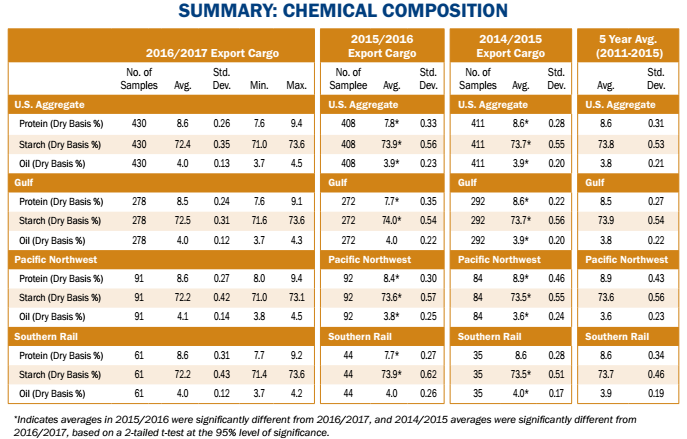C. CHEMICAL COMPOSITION
The chemical composition of corn consists primarily of protein, starch, and oil. Although they are not grade factors, these attributes are of significant interest to end users. They provide information related to nutritional value for livestock and poultry feeding, for wet milling uses, and for other processing uses of corn. Unlike many physical attributes, chemical composition values are not expected to change significantly during storage or transit.
SUMMARY: CHEMICAL COMPOSITION
- Average U.S. Aggregate protein concentration at export (8.6%) was higher than 2015/2016 and the same as 5YA and the 2016 harvest average.
- Average U.S. Aggregate starch concentration (72.4%) was lower than 2015/2016 and 5YA (73.8%), but similar to the 2016 harvest average (72.5%).
- Average U.S. Aggregate oil concentration (4.0%) was higher than 2015/2016 and 5YA (3.8%), but the same as the 2016 harvest average.
- The standard deviations for protein, starch, and oil concentrations were lower and ranges were narrower for the export samples than for the harvest samples.
- Average protein concentrations were slightly higher for contracts loaded as U.S. No. 2 o/b (8.6%) than for contracts loaded as U.S. No. 3 o/b (8.5%); however, average starch and oil concentrations were the same for each contract grade.

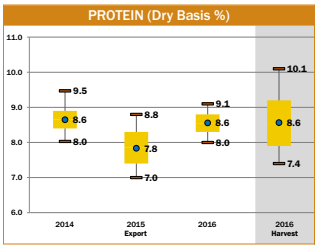
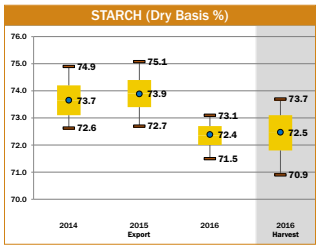
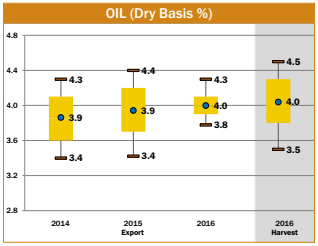
Protein
Protein is very important for poultry and livestock feeding by supplying essential sulfur-containing amino acids and helping to improve feed conversion efficiency. Protein concentration is usually inversely related to starch concentration. Results are reported on a dry basis.
Results
- Average U.S. Aggregate protein concentration (8.6%) was higher than 2015/2016 (7.8%), but the same as 2014/2015 and 5YA (both 8.6%). The average U.S. Aggregate protein concentration at export was the same as the average U.S. Aggregate protein concentration at 2016 harvest (8.6%).
- The 2016/2017 export samples (standard deviation of 0.26%) were more uniform than the 2016 harvest samples (standard deviation of 0.50%). In addition, the range of protein concentration at export (7.6 to 9.4%) was narrower than at harvest (6.8 to 11.7%). The uniformity is due, in part, to grains becoming more homogenous as they are aggregated from numerous harvest-level sources.

- The 2016/2017 export samples were distributed with 30.2% of protein concentrations below 8.5%, compared to 91% of the 2015/2016 samples and 22% of the 2014/2015 samples.
- The Gulf ECA (8.5%) had a lower average protein concentration than the Pacific Northwest and the Southern Rail ECAs (both 8.6%).
- Average protein concentrations were slightly higher for contracts loaded as U.S. No. 2 o/b (8.6%) than for contracts loaded as U.S. No. 3 o/b (8.5%).
Starch
Starch is an important factor for corn used by wet millers and dry-grind ethanol manufacturers. High starch concentration is often indicative of good kernel maturation and/or filling conditions and often results in high kernel densities. Starch concentration is usually inversely related to protein concentration. Results are reported on a dry basis.
Results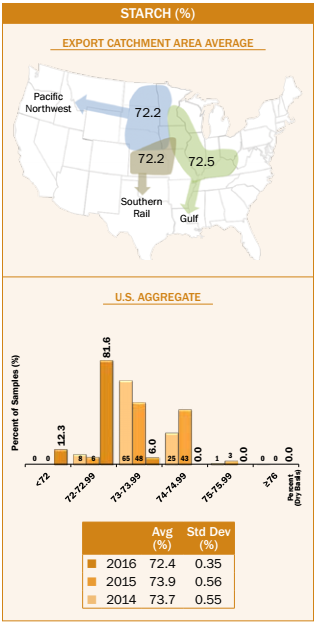
- Average U.S. Aggregate starch concentration (72.4%) was lower than 2015/2016 (73.9%) and 5YA (73.8%). The lower average starch and higher average protein concentrations reflect the typical inverse relationship between starch and protein concentrations.
- Average starch concentration at export (72.4%) was about the same as at harvest (72.5%).
- The standard deviation for starch concentration of the 2016/2017 export samples (0.35%) was lower than the standard deviation of the 2016 harvest samples (0.59%).
- Starch concentrations were distributed with 6.0% at or above 73.0%, compared to 94% in 2015/2016 and 91% in 2014/2015. This indicates fewer 2016/2017 samples had 73.0% or higher starch concentration compared to the previous two years.
- The Gulf ECA had the highest average starch concentration (72.5%), in comparison to the Pacific Northwest and Southern Rail ECAs (both 72.2%). Average starch concentrations have also been highest for the Gulf ECA in 2015/2016, 2014/2015, and for 5YA.
- Average starch concentration for contracts loaded as U.S. No. 2 o/b (72.4%) was the same as that for contracts loaded as U.S. No. 3 o/b.
Oil
Oil is an essential component of poultry and livestock rations. It serves as an energy source, enables fat-soluble vitamins to be utilized, and provides certain essential fatty acids. Oil is also an important co-product of corn wet and dry milling. Results are reported on a dry basis.
Results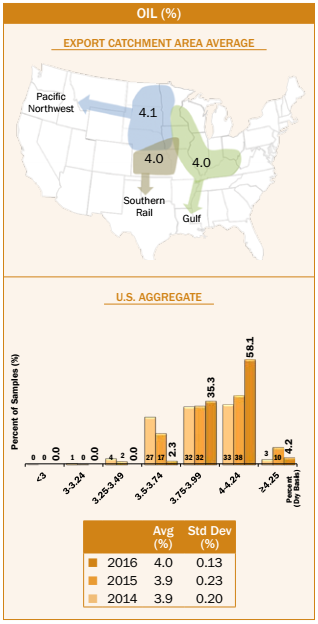
- Average U.S. Aggregate oil concentration (4.0%) was higher than 2015/2016 (3.9%) and 5YA (3.8%).
- The average oil concentration for the 2016/2017 export samples was the same as the 2016 harvest samples (both 4.0%), while the standard deviation at export (0.13%) was lower than at harvest (0.23%).
- The 2016/2017 samples showed a higher percentage of samples above 3.75% oil than in the previous two years. Approximately 98% of the 2016/2017 samples contained at least 3.75% oil, in contrast to 80% in 2015/2016 and 68% in 2014/2015.
- Average oil concentration for the Pacific Northwest ECA (4.1%) was slightly higher than for the Gulf and Southern Rail ECAs (both 4.0%).
- Average U.S. Aggregate and Gulf ECA oil concentrations for contracts loaded as U.S. No. 2 o/b (4.0%) were the same as contracts loaded as U.S. No. 3 o/b.
